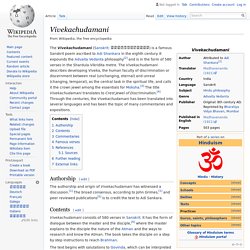

The “Ur” of Dagoth, and the Psudosexual Nature of the Blight : teslore. Samadhi - Wikipedia. A state of meditative consciousness in Indian religions Samādhi (Sanskrit: समाधी, also called samāpatti), in Hinduism, Jainism, Buddhism, Sikhism and yogic schools, is a state of meditative consciousness.

In the yogic traditions, and the Buddhist commentarial tradition on which the Burmese Vipassana movement and the Thai Forest tradition rely, it is a meditative absorption or trance, attained by the practice of dhyāna. In the oldest Buddhist suttas, on which several contemporary western Theravada teachers rely, it refers to the development of a luminous mind which is equanimous and mindful. Definitions[edit] Etymology[edit] Sanskrit[edit] Various interpretations for the term's etymology are possible: Chinese[edit] Common Chinese terms for samādhi include the transliterations sanmei (三昧) and sanmodi (三摩地 or 三摩提), as well as the translation of the term literally as ding (定 "fixity").
VEHK is a Four-Letter Word: Tetragrammatical Significance in Tamriel : teslore. Scourgicus comments on Symbolism of Foul Murder. Sordak comments on How did Indoril Nerevar die? Examining the Name Vehk, a Crowley Perspective : teslore. The “Ur” of Dagoth, and the Psudosexual Nature of the Blight : teslore. Les Infos De Kama Fyr - La Bibliothèque des anciens manuscrits. J'ai recherché d'autres informations que Kama Fyr aurait pu nous donner.

J'ai sans doute passé à côté de certaines, mais il y a pas mal de choses que j'ai tout de même repéré. Je vous les présenterai au fur et à mesure avec une analyse, car il y a pas mal de choses à dire. Son message du 12/11/09 répond à un topic sur les Falmer, dont l'auteur demande ce qu'on sait à leur propos. Citation Three kings for three queens. The brightest star is the one in the darkest sky. Traduction littérale et à-l'arrache :Trois rois pour trois reines. La plus brillante étoile est celle dans le plus sombre ciel. Tout cela est assez... bizarre. Chanson de Hrormir, qui apparaît pour la première fois dans Oblivion, avec le Bâton de glace de Hrormir. Je vais faire une courte analyse. Trois rois pour trois reines [...]
La trinité se retrouve souvent dans les TES. Les Anticipations. La Chanson de Hrormir dit que la Sorcières des Ombres, Nocturne, est la mère des trois rois d'Aelfendor. Et ils étaient la[les?] Vivekachudamani. The Vivekachudamani (Sanskrit: विवेकचूडामणि) is a famous Sanskrit poem ascribed to Adi Shankara in the eighth century.

It expounds the Advaita Vedanta philosophy[2] and is in the form of 580 verses in the Shardula Vikridita metre. The Vivekachudamani describes developing Viveka, the human faculty of discrimination or discernment between real (unchanging, eternal) and unreal (changing, temporal), as the central task in the spiritual life, and calls it the crown jewel among the essentials for Moksha.[3] The title Vivekachudamani translates to Crest Jewel of Discrimination.[4] Through the centuries, the Vivekachudamani has been translated into several languages and has been the topic of many commentaries and expositions. Authorship[edit] The authorship and origin of Vivekachudamani has witnessed a discussion.[1] The broad consensus, according to John Grimes,[1] and peer reviewed publications[5] is to credit the text to Adi Sankara.
Contents[edit] Moksha. In Indian religions and Indian philosophy, moksha (Sanskrit: मोक्ष mokṣa), also called vimoksha, vimukti and mukti,[1] means emancipation, liberation or release.[2] In the soteriological and eschatological sense, it connotes freedom from saṃsāra, the cycle of death and rebirth.

In the epistemological and psychological sense, moksha connotes freedom, self-realization and self-knowledge.[4] In Hindu traditions, moksha is a central concept[5] and included as one of the four aspects and goals of human life; the other three goals are dharma (virtuous, proper, moral life), artha (material prosperity, income security, means of life), and kama (pleasure, sensuality, emotional fulfillment).[6] Together, these four aims of life are called Puruṣārtha in Hinduism.[7]
36 Lessons of Vivec. You have discovered the sixth Sermon of Vivec, which was hidden in the words that came next to the Hortator.

There is an eon within itself that when unraveled becomes the first sentence of the world. Mephala and Azura are the twin gates of tradition and Boethiah is the secret flame. The Sun shall be eaten by lions, which cannot be found yet in Veloth. A Vehk Egg Scramble Part VI: Psjjjj, The Endeavor And A Side (Psijic) Order : teslore. A Vehk Egg Scramble Part V: The Remaining Beaten Egg-Children : teslore. A Vehk Egg Scramble Part IV: Children of Egg Trauma, the First Four : teslore. A Vehk Egg Scramble Part III: An Egg With Four Corners : teslore. A Vehk Egg Scramble Part II: The Pomegranate Disorder: Building the Provisional House of Depersonalization : teslore.
A Vekh Egg Scramble Part I: An Egg Bearing Preamble : teslore. Symbolism of Vivec Artifacts : teslore. The New Whirling School.